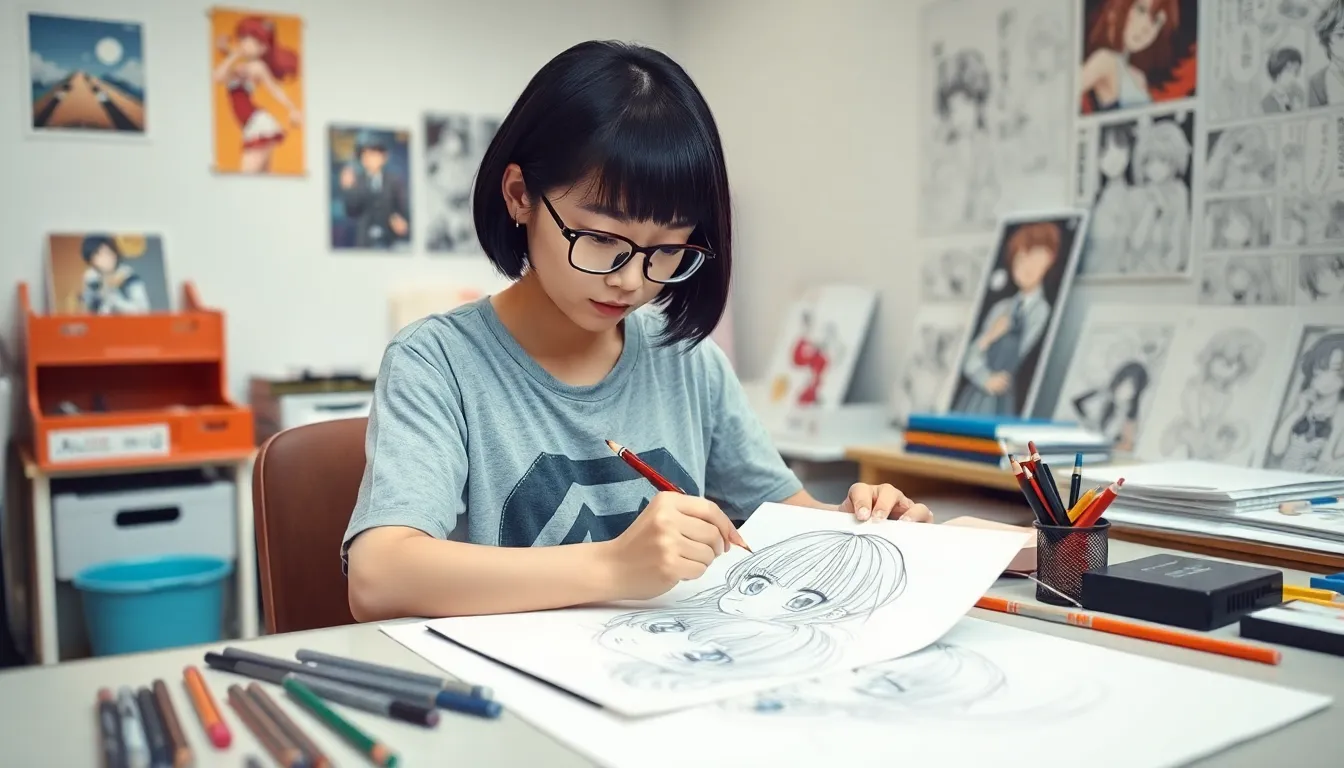Manga art is more than just drawings; it’s a vibrant universe where emotions leap off the page and characters practically beg to be your new best friends. From epic battles to heartwarming romances, manga captures it all with a flair that leaves readers glued to their seats. If you’ve ever found yourself chuckling at a quirky character or gasping at a plot twist, you know the magic that manga brings.
What Is Manga Art
Manga art represents a unique visual storytelling style rooted in Japanese culture. This art form encompasses various genres and appeals to diverse audiences.
Definition of Manga Art
Manga art consists of illustrated narratives characterized by distinct style choices. It features expressive characters, dynamic layouts, and a range of emotional tones. Artists utilize exaggerated facial expressions and stylized backgrounds to enhance storytelling. Manga can be serialized in magazines or published as standalone volumes. The art contributes significantly to character development, plot progression, and the overall atmosphere.
Historical Background
Manga’s origins trace back to the 12th century with early illustrated narratives. By the Edo period, woodblock prints became popular, influencing modern manga artists. The 20th century saw manga’s growth, complemented by American comics and post-war Japanese culture. Influential figures like Osamu Tezuka played crucial roles in establishing the manga format. Today, manga enjoys global recognition, with trends evolving to reflect contemporary society and technology.
Characteristics of Manga Art

Manga art features distinct visual styles and storytelling techniques that set it apart from other forms of graphic literature. Understanding these characteristics provides insight into its unique appeal.
Visual Style
Manga art employs a recognizable visual style characterized by clean lines and meticulous details. Characters often possess large, expressive eyes that convey emotions deeply. Dynamic panel layouts create a sense of movement and energy, enhancing action sequences. Additionally, unique hairstyles and exaggerated facial expressions capture attention, reflecting characters’ inner thoughts. Backgrounds often vary in detail, with simple designs used to focus readers on character interactions during intense moments. This visual approach effectively immerses readers, allowing them to engage with the story on multiple levels.
Storytelling Techniques
Manga incorporates various storytelling techniques that enhance narrative depth. Sequential art leads readers through stories in a way that builds suspense and excitement. Dialogue placement within panels influences pacing and emotional impact, while varying panel sizes emphasize important moments. Flashbacks and dream sequences frequently appear, enriching character backgrounds and motivations. Themes range from adventure to romance, appealing to diverse audiences. Symbolic imagery often accompanies narrative elements, providing deeper meaning and connections. Thus, manga art captivates readers, making it a vital medium in the world of storytelling.
The Evolution of Manga Art
Manga art has transformed significantly over the centuries, adapting to cultural shifts and technological advancements.
Traditional vs. Modern Manga
Traditional manga features distinct characteristics such as monochrome illustrations and intricate line work. Readers often encounter narratives steeped in history and culture, emphasizing visual storytelling techniques that stand the test of time. Modern manga embraces vibrant colors and digital artistry, appealing to contemporary audiences. Artists now utilize diverse genres like fantasy, science fiction, and slice-of-life, broadening the scope of storytelling. The evolution reflects societal changes, showcasing modern themes of identity and relationships.
Influence of Technology
Technology has played a pivotal role in the evolution of manga art. Digital tools enable artists to create intricate designs with ease, allowing for quicker production timelines. Webtoons and digital platforms have expanded access, reaching global audiences and facilitating diverse storytelling. Additionally, social media allows creators to showcase their work, gaining immediate feedback and building fan communities. The rise of anime adaptations has also heightened interest in manga, enhancing its impact in popular culture.
Cultural Impact of Manga Art
Manga art has profoundly influenced global culture, resonating with audiences across different countries.
Global Popularity
Popularity of manga has surged since the 20th century, capturing readers worldwide. The medium reaches millions, with an estimated 100 million manga volumes sold yearly in Japan alone. North America and Europe follow closely, showcasing significant growth in readership. The rise of digital platforms has enabled access to vast libraries, making it easier for fans to explore various genres. Merchandise like clothing, figurines, and video games further amplifies the reach of manga. Conventions dedicated to anime and manga attract thousands, facilitating community building and celebrating creators. Overall, global popularity has transformed manga into a cultural phenomenon.
Representation in Other Media
Representation of manga extends beyond printed pages into various media forms. Live-action films, animated series, and video games often adapt popular titles, introducing stories to broader audiences. Prominent adaptations, such as “Attack on Titan” and “Naruto,” have gained international acclaim and increased manga readership. Collaborations between manga artists and game developers further solidify its presence in gaming culture. Additionally, graphic novels and webcomics draw inspiration from manga’s unique visual style and storytelling techniques. Representation in diverse media showcases the versatility of manga art and its ever-expanding influence on global entertainment.
Conclusion
Manga art stands as a powerful medium that transcends cultural boundaries and captivates audiences worldwide. Its unique blend of expressive visuals and compelling narratives creates an immersive experience that resonates with readers of all ages. The evolution of manga reflects the dynamic nature of storytelling, continually adapting to societal changes and technological advancements.
As manga continues to gain popularity globally, its influence on various forms of media is undeniable. From anime adaptations to merchandise and conventions, manga has carved out a significant place in contemporary culture. This vibrant art form not only entertains but also fosters a sense of community among fans, ensuring its lasting impact for generations to come.





